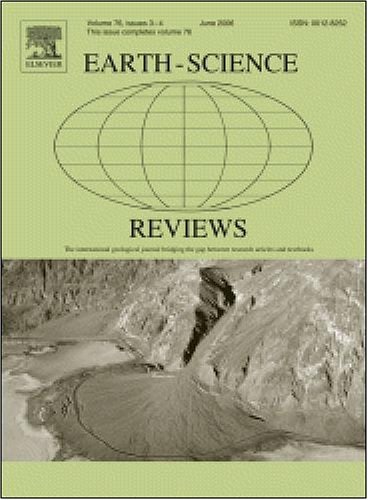密西西比河谷型铅锌矿与热液白云岩的耦合关系及其成矿作用
IF 10.8
1区 地球科学
Q1 GEOSCIENCES, MULTIDISCIPLINARY
引用次数: 0
摘要
白云岩的沉积、成岩作用及其后续演化是盆地沉积史、蒸发岩形成记录过程、密西西比河谷型锌铅(Zn-Pb)矿床和油气成藏的重要地质过程。本文对MVT铅锌矿床的构造格局、白云岩的形成过程、热液白云岩与MVT铅锌矿床的时空关系以及可能的流体运移机制进行了全面的研究和探讨。这些发现阐明了寄主白云岩与MVT型铅锌矿床的耦合关系,最终建立了成矿模式。在地球地质系统中,几乎所有含MVT型铅锌矿的盆地或台地都经历了一系列不同埋藏环境的不同地质过程。这些特征包括近地表浅埋环境中准同生白云岩和蒸发岩共存;深层埋藏环境下埋藏白云岩及油气储层的形成;构造隆升环境下热液白云岩和MVT型铅锌矿床的发育。含锌铅矿白云岩是碳酸盐岩与热液流体相互作用的产物,矿体和矿物尺度上均发育矿化蚀变带。矿体通常与热液白云岩的柱状体或板状体伴生,或两者的混合,或与热液白云岩的板状体相交。硫化物的沉淀很可能发生在白云岩由替代型向鞍型转变的过程中。在成矿阶段,流体温度升高和高离子浓度有利于热液白云化作用和热化学硫酸盐还原作用,是控制白云岩与MVT型铅锌矿床时空共存的主要因素。热液白云岩的晶格结构和化学组成可以为研究相关盆地内的物质来源、流体运移途径和还原硫输运机制提供有价值的信息。在全球范围内,原位热化学硫酸盐还原被认为是典型MVT锌铅矿中还原性硫生成的主要途径。MVT铅锌矿床与白云岩形成的共成模式可划分为三个不同的阶段。在这个模型中,第一阶段被认为可能为第三阶段产生丰富的硫源,而第二阶段为随后的矿化提供了丰富的还原剂。MVT铅锌矿床与白云岩的耦合关系主要受含矿盆地内多种流体的复杂相互作用支配。该模型不仅提高了我们对MVT锌铅矿床成矿过程和相关白云化作用的认识,而且为指导未来的矿产找矿和勘探工作提供了有价值的见解。本文章由计算机程序翻译,如有差异,请以英文原文为准。

Coupling relationship of the Mississippi Valley-type zinc‑lead deposit and hydrothermal dolostone: Its role in metallogeny
The deposition, diagenesis, and subsequent evolution of dolostones are vital geological processes in basin sedimentary history, recording processes of evaporite formation, the Mississippi Valley–type (MVT) zinc–lead (Zn–Pb) deposit, and hydrocarbon accumulation. This review provides a comprehensive investigation and discussion on the tectonic framework of the MVT Zn–Pb deposits, the processes of dolostone formation, the spatiotemporal relationships between hydrothermal dolostone and MVT Zn–Pb deposits, and potential fluid migration mechanisms. These findings elucidate the coupling relationship between host dolostone and MVT Zn–Pb deposits, ultimately leading to the establishment of a metallogenic model.
In the Earth's geological system, nearly all basins or platforms bearing the MVT Zn–Pb deposits have undergone a sequence of distinct geological processes across different burial environments. These include the coexistence of penecontemporaneous dolostone and evaporites in the near-surface, shallow burial setting; the formation of burial dolostone and oil or gas reservoirs in deeper burial environment; and the development of hydrothermal dolostone and MVT Zn–Pb deposits in tectonic uplift setting.
The Zn–Pb ore-bearing dolostone originates from the interaction of carbonate rocks with hydrothermal fluids, as evidenced by the development of mineralised alteration zones at both the orebody and mineral scales. Orebodies are typically associated with columnar or tabular bodies of hydrothermal dolostone, or a mixture of both, or intersect the tabular body of the hydrothermal dolostone. Sulphides precipitation was likely to have occurred during the transition of dolomite from the replacement to saddle form. During the metallogenic stage, elevated fluid temperatures and high ion concentrations facilitate hydrothermal dolomitisation and thermochemical sulphate reduction processes, which were the primary factor controlling the spatiotemporal coexistence of dolostone and MVT Zn–Pb deposits. The lattice structure and chemical composition of hydrothermal dolomite can provide valuable insights into the sources of material, fluid migration pathways, and the transport mechanisms of reduced sulphur within related basins. Globally, in-situ thermochemical sulphate reduction is recognized as the dominant pathway for reduced sulphur generation in typical MVT Zn–Pb deposits.
The cogenetic model of MVT Zn–Pb deposits and dolostone formation can be divided into three distinct stages. In this model, the the first stage is thought to potentially generate abundant sulphur sources for the third stage, while the second stage provides rich reducing agents necessary for subsequent mineralisation. The coupling relationship between MVT Zn–Pb deposit and dolostone is primarily governed by the complex interactions of diverse fluids within the ore-bearing basins. This refined model not only enhances our understanding of the mineralisation processes of MVT Zn–Pb deposits and the associated dolomitization but also offers valuable insights for guiding future mineral prospecting and exploration efforts.
求助全文
通过发布文献求助,成功后即可免费获取论文全文。
去求助
来源期刊

Earth-Science Reviews
地学-地球科学综合
CiteScore
21.70
自引率
5.80%
发文量
294
审稿时长
15.1 weeks
期刊介绍:
Covering a much wider field than the usual specialist journals, Earth Science Reviews publishes review articles dealing with all aspects of Earth Sciences, and is an important vehicle for allowing readers to see their particular interest related to the Earth Sciences as a whole.
 求助内容:
求助内容: 应助结果提醒方式:
应助结果提醒方式:


